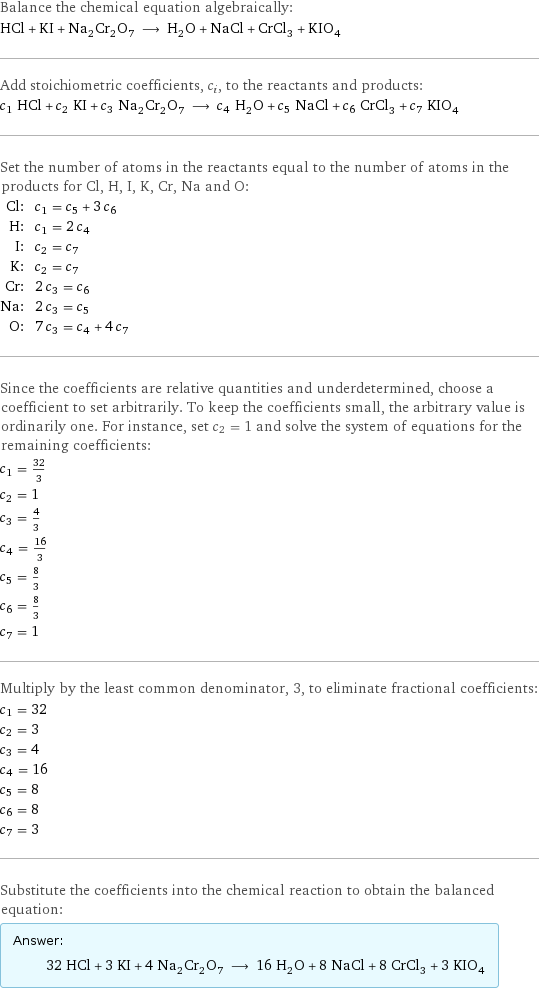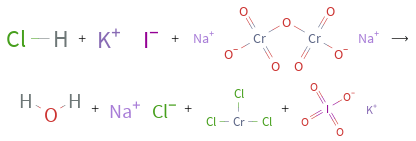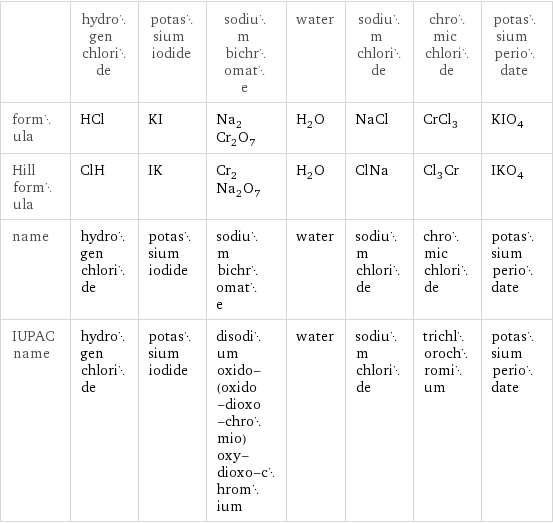Input interpretation

HCl hydrogen chloride + KI potassium iodide + Na_2Cr_2O_7 sodium bichromate ⟶ H_2O water + NaCl sodium chloride + CrCl_3 chromic chloride + KIO_4 potassium periodate
Balanced equation

Balance the chemical equation algebraically: HCl + KI + Na_2Cr_2O_7 ⟶ H_2O + NaCl + CrCl_3 + KIO_4 Add stoichiometric coefficients, c_i, to the reactants and products: c_1 HCl + c_2 KI + c_3 Na_2Cr_2O_7 ⟶ c_4 H_2O + c_5 NaCl + c_6 CrCl_3 + c_7 KIO_4 Set the number of atoms in the reactants equal to the number of atoms in the products for Cl, H, I, K, Cr, Na and O: Cl: | c_1 = c_5 + 3 c_6 H: | c_1 = 2 c_4 I: | c_2 = c_7 K: | c_2 = c_7 Cr: | 2 c_3 = c_6 Na: | 2 c_3 = c_5 O: | 7 c_3 = c_4 + 4 c_7 Since the coefficients are relative quantities and underdetermined, choose a coefficient to set arbitrarily. To keep the coefficients small, the arbitrary value is ordinarily one. For instance, set c_2 = 1 and solve the system of equations for the remaining coefficients: c_1 = 32/3 c_2 = 1 c_3 = 4/3 c_4 = 16/3 c_5 = 8/3 c_6 = 8/3 c_7 = 1 Multiply by the least common denominator, 3, to eliminate fractional coefficients: c_1 = 32 c_2 = 3 c_3 = 4 c_4 = 16 c_5 = 8 c_6 = 8 c_7 = 3 Substitute the coefficients into the chemical reaction to obtain the balanced equation: Answer: | | 32 HCl + 3 KI + 4 Na_2Cr_2O_7 ⟶ 16 H_2O + 8 NaCl + 8 CrCl_3 + 3 KIO_4
Structures

+ + ⟶ + + +
Names

hydrogen chloride + potassium iodide + sodium bichromate ⟶ water + sodium chloride + chromic chloride + potassium periodate
Equilibrium constant
![Construct the equilibrium constant, K, expression for: HCl + KI + Na_2Cr_2O_7 ⟶ H_2O + NaCl + CrCl_3 + KIO_4 Plan: • Balance the chemical equation. • Determine the stoichiometric numbers. • Assemble the activity expression for each chemical species. • Use the activity expressions to build the equilibrium constant expression. Write the balanced chemical equation: 32 HCl + 3 KI + 4 Na_2Cr_2O_7 ⟶ 16 H_2O + 8 NaCl + 8 CrCl_3 + 3 KIO_4 Assign stoichiometric numbers, ν_i, using the stoichiometric coefficients, c_i, from the balanced chemical equation in the following manner: ν_i = -c_i for reactants and ν_i = c_i for products: chemical species | c_i | ν_i HCl | 32 | -32 KI | 3 | -3 Na_2Cr_2O_7 | 4 | -4 H_2O | 16 | 16 NaCl | 8 | 8 CrCl_3 | 8 | 8 KIO_4 | 3 | 3 Assemble the activity expressions accounting for the state of matter and ν_i: chemical species | c_i | ν_i | activity expression HCl | 32 | -32 | ([HCl])^(-32) KI | 3 | -3 | ([KI])^(-3) Na_2Cr_2O_7 | 4 | -4 | ([Na2Cr2O7])^(-4) H_2O | 16 | 16 | ([H2O])^16 NaCl | 8 | 8 | ([NaCl])^8 CrCl_3 | 8 | 8 | ([CrCl3])^8 KIO_4 | 3 | 3 | ([KIO4])^3 The equilibrium constant symbol in the concentration basis is: K_c Mulitply the activity expressions to arrive at the K_c expression: Answer: | | K_c = ([HCl])^(-32) ([KI])^(-3) ([Na2Cr2O7])^(-4) ([H2O])^16 ([NaCl])^8 ([CrCl3])^8 ([KIO4])^3 = (([H2O])^16 ([NaCl])^8 ([CrCl3])^8 ([KIO4])^3)/(([HCl])^32 ([KI])^3 ([Na2Cr2O7])^4)](../image_source/fa7b4ea3e1519331a0cfc4938d4dc730.png)
Construct the equilibrium constant, K, expression for: HCl + KI + Na_2Cr_2O_7 ⟶ H_2O + NaCl + CrCl_3 + KIO_4 Plan: • Balance the chemical equation. • Determine the stoichiometric numbers. • Assemble the activity expression for each chemical species. • Use the activity expressions to build the equilibrium constant expression. Write the balanced chemical equation: 32 HCl + 3 KI + 4 Na_2Cr_2O_7 ⟶ 16 H_2O + 8 NaCl + 8 CrCl_3 + 3 KIO_4 Assign stoichiometric numbers, ν_i, using the stoichiometric coefficients, c_i, from the balanced chemical equation in the following manner: ν_i = -c_i for reactants and ν_i = c_i for products: chemical species | c_i | ν_i HCl | 32 | -32 KI | 3 | -3 Na_2Cr_2O_7 | 4 | -4 H_2O | 16 | 16 NaCl | 8 | 8 CrCl_3 | 8 | 8 KIO_4 | 3 | 3 Assemble the activity expressions accounting for the state of matter and ν_i: chemical species | c_i | ν_i | activity expression HCl | 32 | -32 | ([HCl])^(-32) KI | 3 | -3 | ([KI])^(-3) Na_2Cr_2O_7 | 4 | -4 | ([Na2Cr2O7])^(-4) H_2O | 16 | 16 | ([H2O])^16 NaCl | 8 | 8 | ([NaCl])^8 CrCl_3 | 8 | 8 | ([CrCl3])^8 KIO_4 | 3 | 3 | ([KIO4])^3 The equilibrium constant symbol in the concentration basis is: K_c Mulitply the activity expressions to arrive at the K_c expression: Answer: | | K_c = ([HCl])^(-32) ([KI])^(-3) ([Na2Cr2O7])^(-4) ([H2O])^16 ([NaCl])^8 ([CrCl3])^8 ([KIO4])^3 = (([H2O])^16 ([NaCl])^8 ([CrCl3])^8 ([KIO4])^3)/(([HCl])^32 ([KI])^3 ([Na2Cr2O7])^4)
Rate of reaction
![Construct the rate of reaction expression for: HCl + KI + Na_2Cr_2O_7 ⟶ H_2O + NaCl + CrCl_3 + KIO_4 Plan: • Balance the chemical equation. • Determine the stoichiometric numbers. • Assemble the rate term for each chemical species. • Write the rate of reaction expression. Write the balanced chemical equation: 32 HCl + 3 KI + 4 Na_2Cr_2O_7 ⟶ 16 H_2O + 8 NaCl + 8 CrCl_3 + 3 KIO_4 Assign stoichiometric numbers, ν_i, using the stoichiometric coefficients, c_i, from the balanced chemical equation in the following manner: ν_i = -c_i for reactants and ν_i = c_i for products: chemical species | c_i | ν_i HCl | 32 | -32 KI | 3 | -3 Na_2Cr_2O_7 | 4 | -4 H_2O | 16 | 16 NaCl | 8 | 8 CrCl_3 | 8 | 8 KIO_4 | 3 | 3 The rate term for each chemical species, B_i, is 1/ν_i(Δ[B_i])/(Δt) where [B_i] is the amount concentration and t is time: chemical species | c_i | ν_i | rate term HCl | 32 | -32 | -1/32 (Δ[HCl])/(Δt) KI | 3 | -3 | -1/3 (Δ[KI])/(Δt) Na_2Cr_2O_7 | 4 | -4 | -1/4 (Δ[Na2Cr2O7])/(Δt) H_2O | 16 | 16 | 1/16 (Δ[H2O])/(Δt) NaCl | 8 | 8 | 1/8 (Δ[NaCl])/(Δt) CrCl_3 | 8 | 8 | 1/8 (Δ[CrCl3])/(Δt) KIO_4 | 3 | 3 | 1/3 (Δ[KIO4])/(Δt) (for infinitesimal rate of change, replace Δ with d) Set the rate terms equal to each other to arrive at the rate expression: Answer: | | rate = -1/32 (Δ[HCl])/(Δt) = -1/3 (Δ[KI])/(Δt) = -1/4 (Δ[Na2Cr2O7])/(Δt) = 1/16 (Δ[H2O])/(Δt) = 1/8 (Δ[NaCl])/(Δt) = 1/8 (Δ[CrCl3])/(Δt) = 1/3 (Δ[KIO4])/(Δt) (assuming constant volume and no accumulation of intermediates or side products)](../image_source/4f71bd7c44030f2b9fc2606ec796fcbc.png)
Construct the rate of reaction expression for: HCl + KI + Na_2Cr_2O_7 ⟶ H_2O + NaCl + CrCl_3 + KIO_4 Plan: • Balance the chemical equation. • Determine the stoichiometric numbers. • Assemble the rate term for each chemical species. • Write the rate of reaction expression. Write the balanced chemical equation: 32 HCl + 3 KI + 4 Na_2Cr_2O_7 ⟶ 16 H_2O + 8 NaCl + 8 CrCl_3 + 3 KIO_4 Assign stoichiometric numbers, ν_i, using the stoichiometric coefficients, c_i, from the balanced chemical equation in the following manner: ν_i = -c_i for reactants and ν_i = c_i for products: chemical species | c_i | ν_i HCl | 32 | -32 KI | 3 | -3 Na_2Cr_2O_7 | 4 | -4 H_2O | 16 | 16 NaCl | 8 | 8 CrCl_3 | 8 | 8 KIO_4 | 3 | 3 The rate term for each chemical species, B_i, is 1/ν_i(Δ[B_i])/(Δt) where [B_i] is the amount concentration and t is time: chemical species | c_i | ν_i | rate term HCl | 32 | -32 | -1/32 (Δ[HCl])/(Δt) KI | 3 | -3 | -1/3 (Δ[KI])/(Δt) Na_2Cr_2O_7 | 4 | -4 | -1/4 (Δ[Na2Cr2O7])/(Δt) H_2O | 16 | 16 | 1/16 (Δ[H2O])/(Δt) NaCl | 8 | 8 | 1/8 (Δ[NaCl])/(Δt) CrCl_3 | 8 | 8 | 1/8 (Δ[CrCl3])/(Δt) KIO_4 | 3 | 3 | 1/3 (Δ[KIO4])/(Δt) (for infinitesimal rate of change, replace Δ with d) Set the rate terms equal to each other to arrive at the rate expression: Answer: | | rate = -1/32 (Δ[HCl])/(Δt) = -1/3 (Δ[KI])/(Δt) = -1/4 (Δ[Na2Cr2O7])/(Δt) = 1/16 (Δ[H2O])/(Δt) = 1/8 (Δ[NaCl])/(Δt) = 1/8 (Δ[CrCl3])/(Δt) = 1/3 (Δ[KIO4])/(Δt) (assuming constant volume and no accumulation of intermediates or side products)
Chemical names and formulas

| hydrogen chloride | potassium iodide | sodium bichromate | water | sodium chloride | chromic chloride | potassium periodate formula | HCl | KI | Na_2Cr_2O_7 | H_2O | NaCl | CrCl_3 | KIO_4 Hill formula | ClH | IK | Cr_2Na_2O_7 | H_2O | ClNa | Cl_3Cr | IKO_4 name | hydrogen chloride | potassium iodide | sodium bichromate | water | sodium chloride | chromic chloride | potassium periodate IUPAC name | hydrogen chloride | potassium iodide | disodium oxido-(oxido-dioxo-chromio)oxy-dioxo-chromium | water | sodium chloride | trichlorochromium | potassium periodate